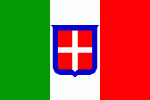
Italian Tripolitania
Quick reference
General issues: Italian colony 1923-1938
Country name on general issues: Tripoli, Tripolitania
Special issues: Italian office Tripoli 1909, British military administration 1948-1950, British administration 1950-1951
Related issues: British military administration, Middle East Forces 1943-1948
Currency: 1 Lira = 100 Centesimi 1923-1938, 1 Pound = 480 Military Administration Lira
Population: 545 000 in 1931
Political history Italian Tripolitania
The opening stages
Italian Tripolitania is located in northern Africa in the current Libya. In the 19th century the future Italian Tripolitania is part of the Ottoman vilayet or province of Tripolitania, that also includes the Cyrenaica and Fezzan regions. Italy, in the 19th century, has commercial interests in Ottoman Tripolitania and by the late 19th century Italy looks to take possession of Ottoman Tripolitania. In 1911, Italy declares war on Turkey. Italy is victorious and in 1912 the Turks, by way of the treaty of Lausanne, agree to withdraw from Tripolitania – de jure Ottoman Tripolitania is ceded to Italy in 1923.
Establishing Italian rule
The Italians, after 1912, divide their Libyan possessions in three parts. In the coastal region the colonies of Italian Tripolitania and Italian Cyrenaica are established, each with a governor. The southern possessions – the Fezzan and Kufra regions – are administered by the military as the Military Territory of Southern Libya. These possessions together are referred to both as ‘Italian North Africa’ and ‘Italian Libya’.
Having gained control only over the coastal regions in 1912, Italy next sets out to bring all of Ottoman Tripolitania under its control – an effort in which it will only partly succeed. In 1915, Italy joins the Allies in WWI and the troops from Libya are withdrawn to be deployed in the European theaters of war. Local leaders reassert their authority over most of Libya. Italian control is, between 1915 and 1919, de facto limited to a number coastal towns. After WWI, the Italians set out to reestablish their authority in Libya. Initially, they do so by signing agreements with the local leaders granting self government. In Italian Tripolitania an agreement is signed with the Tripolitanian republic that has proclaimed independence in 1919.
Things take a very different turn when Benito Mussolini, in 1922, comes to power in Italy. Mussolini launches the ‘Riconquista’[1]‘Reconquest’ . The Italians abrogate all prior agreements and, through military force, assert their authority in Libya. Libya is successively brought under effective Italian rule – Italian Tripolitania between 1922 and 1928. The existence of Italian Tripolitania as a separate colony comes to an end when, in 1934, the colonies of Tripolitania and Cyrenaica are joined to form what is now officially called the colony of Italian Libya.
The population is of Tripolitania is of Berber, Arab and Turkish origin and is almost fully Arabized. The culture is akin to that of the Mahreb – the western part of the Arab world that stretches from Morocco across Algeria and Tunisia to Tripolitania. As such, the population of Tripolitania is distinct from the population in Cyrenaica that is more oriented to the Mashriq – the eastern Arab world stretching from Cyrenaica to the Middle East – and the sparsely populated southern part of Libya. Politically, Tripolitania presents a fragmented picture with several rivaling local leaders – one of the reasons why Tripolitania was the first of the Libyan regions to be brought under effective Italian rule.
British administration
In WWII, Libya will develop into a major theater of war. Fortunes change between 1940 and 1943 but events eventually lead to Allied victory and the eviction of Italy from Libya in 1943. The British and the French divide Libya into three occupation zones under military administration: the British administering Tripolitania and Cyrenaica, the French administering Fezzan & Ghadames. The British in Tripolitania and Cyrenaica set up separate administrations reflecting the different demands in local and international politics. Through the 1947 peace treaty, Italy formally cedes its Libyan possessions. From 1949, the United Nations play an active part in Libyan history. A resolution is passed in 1949 stating that Libya should gain independence as a unified country before 1952. In 1950, civil administration is established and in 1951 Libya gains independence as the kingdom of Libya.
Postal history Italian Tripolitania
Italian Tripolitania
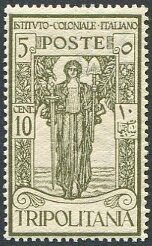
1926 – An allegory of Peace substituting the sword for the spade. A design issued in all Italian colonies initiated by the Colonial Institute.
In Ottoman Tripolitania the stamps of the Ottoman Empire were used. Italy has opened an office abroad in Tripoli in 1869 using general issues for Italian offices abroad from 1874 and the general issues for the Italian offices in the Levant from 1908. Stamps are issued for specific use in the Tripoli office from 1909.
Italy issues stamps for its possessions in Libya from 1912. Stamps issued in the name of Italian Libya and valid throughout Italian Libya from 1912 until 1943. From 1923, stamps are issued for both Italian Tripolitania and Italian Cyrenaica, concurrent with the general issues for Italian Libya. These are almost exclusively commemoratives – both overprints on Italian stamps and issues of designs common to the Italian colonies. The stamps of Italian Tripolitania are, from 1934, superseded by the issues for Italian Libya.
From 1927 until 1939, sets are issued yearly at the occasion of the Tripoli trade fairs. These can be recognized by the inscription ‘Fiera Campionara Tripoli'[2]‘Tripoli Trade Fair’ . Some of these issues have the additional inscription of ‘Poste Italiane’ – the 1927-1931 issues, some ‘Poste coloniali’ – the 1931-1934 issues. The 1936, 1937 and 1939 issues have the additional inscription ‘Libia’. The 1935 and 1938 issues have no further inscription.[3]The world wide catalogs list these sets in different ways. Scott lists all the issues under Libya. Stanley Gibbons lists the issues, until 1935, under Tripolitania and the issues from 1936 under Libya. Michel and Yvert & Tellier list the issues until 1935 and the 1938 issue under (Italian) Tripolitania. The 1936, 1937 and 1939 issues inscribed ‘Libia’ are listed under Libya. The Italian Unificato catalog states that, until 1935 these issues were issued only in Tripolitania, from 1936 in all of Libya.
British administration
After the occupation of Libya by the Allies, stamps are issued by the British and French military administrations. In the British zones, from 1943 to 1948, the issues for the Middle East Forces are used – stamps of Britain overprinted ‘M.E.F’. In 1948, stamps are issued with an overprint reading ‘B.M.A. Tripolitania'[4]‘British Military Administration Tripolitania’ for use in both Tripolitania and Cyrenaica. Further overprints are issued in 1950. The overprint now reads ‘B.A. Tripoliania'[5]‘British Administration Tripolitania’ reflecting the change to civil administration. The ‘B.A.’ issues were valid only in Tripolitania. Cyrenaica, where by then the emirate of Cyrenaica had been established, issued its own stamps.
From 1951, the stamps of the British administration are superseded by the issues of independent Libya.
Album pages
← Previous page: Italian SomalilandNext page: Ivory Coast →

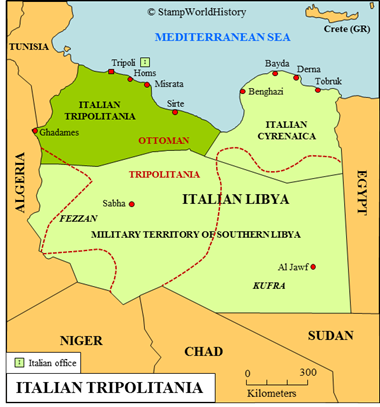
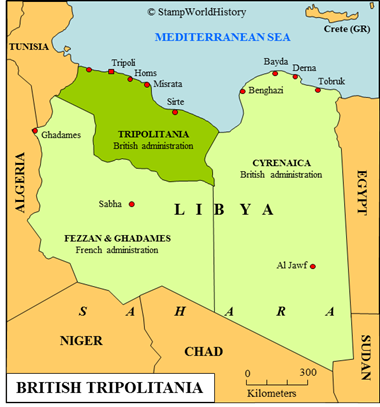

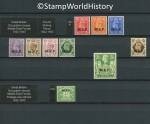
Dear Gerben,
I send few comments about Tripoli Fair issues.
The last, 13th, Tripoli Fair issue is issued in 1939.
All sets in Scott catalogue are listed in Libya.
The I-IX issues (1927-1935) are listed as Tripolitanian ones in Michel and Yvert.
Since 1936 Tripoli Fair stamps are issued with the inscription Libya and are listed in Libya in Michel and Yvert. Exception – 12th issue (1938) is without inscription Libya and is listed as Tripolitanian set in Michel and Yvert. This set is as Libyan one in Unificato 1996 (Italy) catalogue.
The following information about Tripoli fair stamps is in Unificato.
Le emissioni commemorative delle Fiere di Tripoli venivano vendute ed usate soltanto in Tripolitania. Fanno eccezione la X-XIII che emesse dopo l‘unificatione del 1936 ebbero corso in tutta la Libia.
Translation.
The commemorative Tripoli Fair issues were sold and used only in Tripolitania, with the exception of X-XI-XII-XIII (issues) that, issued after unification of 1936, were available for all Libya.
Gedi
Gedi. Thanks. Please note that I have adjusted the text of the profile to reflect the information in your comment.